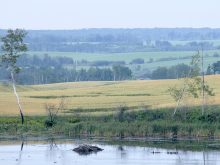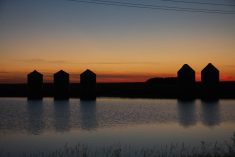NESBITT, Man. – To Dwayne and Shelley Logan’s way of thinking, the first priority of farmers should be to keep themselves fed – and happy – on the land.
In an era when farmers are showing up at food banks and children are mainly grown for export to urban areas, the Logans are a model for small farm sustainability on 340 acres near Nesbitt, Man.
“People might say that I’m poor,” said Dwayne, as he showed off his herd of organically raised Cashmere goats, sheep and Berkshire pigs wallowing in the sunshine.
Read Also

Rural Manitoba resources slim on natural disaster planning
A study from Brandon University’s Rural Development Institute has found that many rural and small municipalities don’t have the staff or resources to make formal climate plans against natural disaster.
“But I heard on the news that the highest priced meal in the United States was an organic Berkshire pork dish served in a New York restaurant,” he said with a smile. “I eat that every day.”
Starting off with a quarter section nine years ago, they have added another quarter and are planning to buy a third with more buildings. Their family is growing as well with Shelley expecting a baby in two months.
The Logans were winners of the $2,000 grand prize for the best business plan in the recent Small Farms Challenge, sponsored by the Turtle Mountain Development Corp., based in nearby Boissevain. Their diversified small farm model features a low-debt strategy aimed at achieving self-sufficiency, improving the land base and enjoying a good quality of life.
The contest aimed at encouraging discussion about the best way to repopulate rural areas received 27 entries from three provinces and North Dakota, ranging from how to make a living on a quarter section to a design for an eco-village.
Shelley’s garden and Daisy the Jersey cow provide them with fresh vegetables, milk, butter and ice cream. Their 30 head of beef cattle supply meat and cash income.
Nearby stands a small shed perched on a steel-wheeled wagon that they picked up at an auction sale. They plan to use it to shelter 200 dual-purpose rare-breed pastured chickens this summer. The roosters will be slaughtered and the hens kept over the winter as layers.
“We probably couldn’t afford to eat 100 percent organic if we bought it in the stores,” said Dwayne. “But we’re always well fed.”
Finding creative ways to save money is a big part of their strategy and a source of pride and joy.
Their seven by 10 metre barn, which cost $700, was built using laminated truss rafters salvaged from a derelict barn and covered with a huge tarp bought second hand. Their entire collection of farm machinery, still in good working condition, cost about $10,000 in total. Dwayne paid $1,000 for the combine, a John Deere 6601.
“All of it is still in good shape. They’re made for a smaller scale operation, so nobody wants them anymore.”
Cheaper used equipment means less worries about payments and interest, yet they still do the job on the farm’s organic cropland, which rotates small grains with sweet clover.
By concentrating on net income and staying small and as debt-free as possible, the Logans say, a farmer has less stress and more free time for family and friends, as well as hobbies.
Cash flow is manageable, but raising capital is a big problem, he said.
“There’s a lot of prejudice against this scale of operation. Big farmers may have a few good years and make a lot of money, but I’ll always do OK and be content and happy,” he said. “I might not make millions, but I won’t lose them, either.”
Dwayne’s pioneer-style inclinations show in his other interests besides farming, which include brain-tanning buckskin and blacksmithing. He teaches wilderness survival courses, but laments the dearth of instructors in the art of hammer and forge.
Along with heritage breeds of livestock, he noted that many rural skills are being lost that someday might be needed in a future when fossil fuels are either gone or too expensive to buy.
Working his fields with horses appeals to his sense of economy, but he lacks knowledge and experience. As with many of the formerly commonplace but now dying arts, finding a mentor is the biggest obstacle.
“Any old person that we can find, we just latch on and try to learn as much as we can. We’re always reading and experimenting. We’re always keen to learn,” he said.
The growing trend toward buying food locally is a sign that farms like theirs could be in a good position to thrive in the future, said Dwayne. Part of their strategy is to market excess produce at the farmgate to generate cash flow.
“I think that local is more important than organic or anything else. It would provide a good living for farm families and reduce fuel use,” Dwayne said.
“A guy from New York once asked me what my favourite food was. I said baby potatoes. His jaw dropped. ‘Potatoes! They’re dry, boring, just filler.’ He had never tasted them fresh out of the garden.”














